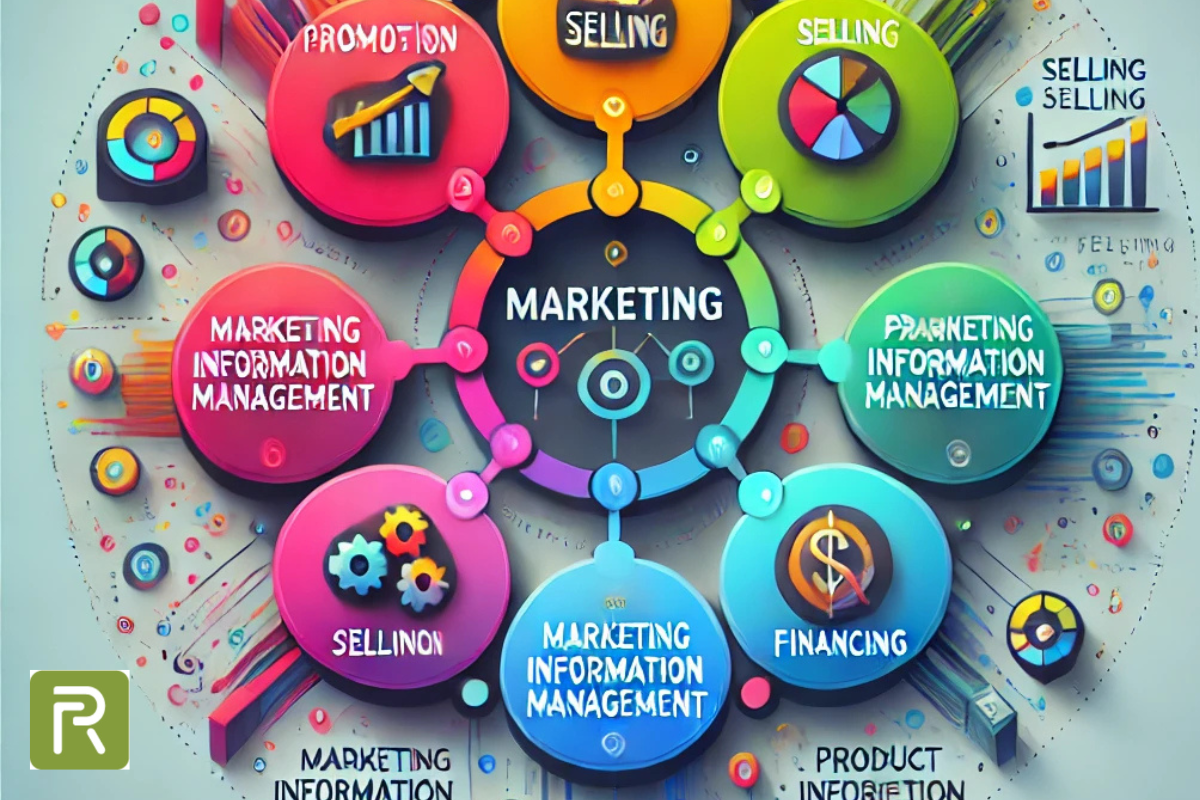7 Functions of Marketing: Essential Roles in Business Success
Introduction
Marketing is the backbone of any successful business. Beyond creating advertisements, it encompasses a set of systematic functions designed to connect products or services with the right audience. The 7 functions of marketing serve as the foundation for developing effective strategies that drive growth, enhance customer satisfaction, and maximize revenue.
This article breaks down each of these functions, providing actionable insights for businesses looking to strengthen their marketing game.
1. Promotion
Promotion is about communicating the value of a product or service to the target audience. Its primary goal is to inform, persuade, and remind customers about what a business offers.
Key Aspects:
- Advertising: Campaigns through TV, social media, and print.
- Sales Promotions: Discounts, giveaways, and limited-time offers.
- Public Relations (PR): Building brand reputation through events or media coverage.
Example: A company launching a new smartphone may use social media ads, influencer partnerships, and pre-launch deals to promote the product.
2. Product and Service Management
This function involves planning, developing, and maintaining products that meet consumer needs. Effective product management ensures a business stays competitive by adapting to market trends.
Key Aspects:
- Conducting market research to identify consumer demands.
- Innovating or improving existing products.
- Managing product lifecycle from introduction to maturity.
Example: Starbucks regularly updates its menu with seasonal drinks like pumpkin spice lattes, catering to changing consumer tastes.
3. Distribution (Place)
Distribution focuses on getting the product to customers efficiently. This includes determining where, how, and when products are available for purchase.
Key Aspects:
- Selecting appropriate channels, such as e-commerce, retail stores, or wholesalers.
- Managing supply chains to ensure timely delivery.
- Using technology like inventory management systems for efficiency.
Example: Amazon’s fast shipping options and strategic fulfillment centers demonstrate mastery of distribution.
4. Pricing
Pricing involves determining the value a customer is willing to pay for a product or service. It directly impacts profitability, market positioning, and demand.
Key Aspects:
- Setting competitive prices based on market research.
- Using pricing strategies such as penetration pricing, cost-plus pricing, or value-based pricing.
- Adjusting prices for discounts, seasonal promotions, or economic shifts.
Example: Netflix’s tiered pricing strategy accommodates customers with different budget levels while maximizing subscriptions.
5. Selling
Selling is the process of persuading potential customers to purchase a product or service. It includes direct interactions, whether in-store, online, or through personal sales consultations.
Key Aspects:
- Training sales teams to understand product features and benefits.
- Creating personalized experiences for customers.
- Using customer relationship management (CRM) tools to track leads and conversions.
Example: Car dealerships employ skilled sales teams who guide buyers through the decision-making process, offering test drives and financing options.
6. Marketing Information Management
This function revolves around gathering, analyzing, and utilizing data to make informed marketing decisions. Accurate data helps businesses understand their audience and refine their strategies.
Key Aspects:
- Collecting customer feedback via surveys, reviews, and focus groups.
- Monitoring analytics for website traffic, ad performance, and sales trends.
- Using insights to optimize campaigns and improve customer experiences.
Example: Spotify uses user data to recommend playlists and improve its algorithm, ensuring a personalized music experience.
7. Financing
Financing ensures businesses have the resources to implement marketing strategies. It also involves helping customers access financing options to make purchases.
Key Aspects:
- Allocating budgets for advertising campaigns, product launches, and promotions.
- Offering payment plans, credit options, or leasing for high-ticket items.
- Securing funding for expanding marketing operations.
Example: Apple provides financing plans that allow customers to pay for products like iPhones in installments.
How These Functions Work Together
The 7 functions of marketing are interconnected and work as a cohesive system:
- Pricing strategies influence promotion tactics.
- Marketing information guides product development.
- Effective distribution enhances customer satisfaction and sales.
When all functions align, businesses can achieve their goals, such as entering new markets, improving brand loyalty, or boosting revenue.
FAQs
What are the 7 functions of marketing?
The 7 functions include promotion, product and service management, distribution, pricing, selling, marketing information management, and financing.
Why are these functions important?
They help businesses attract customers, drive sales, and create a competitive edge in the market.
Can small businesses apply these functions?
Absolutely. Even with limited resources, small businesses can implement these functions at a scale that fits their operations.
How does marketing information management impact strategy?
It provides data-driven insights that enable businesses to understand customer preferences and refine campaigns for better results.
What’s the role of pricing in marketing?
Pricing affects how customers perceive value and influences purchasing decisions. It’s a critical factor in positioning a brand within its market.
Conclusion
Mastering the 7 functions of marketing is essential for any business aiming to thrive in today’s competitive environment. From crafting compelling promotions to leveraging data for strategic decisions, these functions provide the tools needed to connect with customers and drive growth. By integrating them into your business strategy, you’ll build a strong foundation for success.




